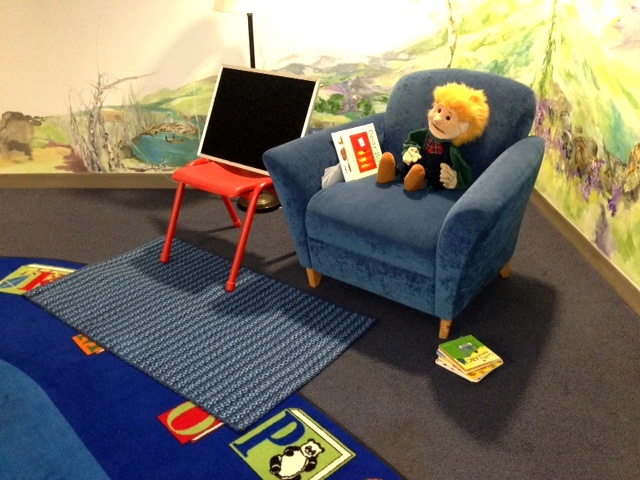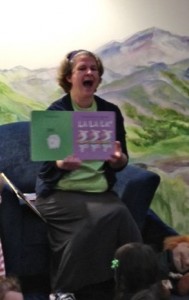AKA How To Use Flannelboards with Babies and Toddlers, with a Big Nod to Mother Goose on the Loose
Yesterday on Twitter Amy asked how I manage to do flannelboards in baby storytime, when it’s so hard for the young toddlers to understand that they aren’t supposed to grab the pieces off the board. This is extra hard if we have a routine of allowing them to play with the pieces AFTER storytime! Understanding why it is okay THEN but not NOW is just not something they can really wrap their heads around.
Another, related, question is: Why is Mel doing flannelboards at ALL in baby storytime? You can argue that flannelboards just aren’t the best activity, developmentally speaking, to present to our youngest audience. Certainly I don’t believe that flannelboards are essential to baby storytime. Songs, bounces, rhymes, snuggles: yes. Flannelboards, not so much. However, I do use them in my storytimes, for a few reasons. One is that my baby storytime is for ages birth through 24 months, and the 18-24 month old toddlers are old enough to enjoy a simple flannel song or rhyme. I also love modeling to parents and caregivers how they could use simple felt pieces at home, and show them how much their kids love such an inexpensive, tactile, open-ended experience. Another reason is personal: I like a little variety, and adding different activities to my storytime helps to keep me engaged.
To accommodate the babies and very small ones, I do a couple of things. I learned a few years ago that 20/20 vision is a developmental milestone not necessarily reached until 2 or 3 years. (While I have seen charts that list 20/20 vision at 6 months, see also here, or scroll to find the chart here.) I immediately tossed all my tiny flannelboard pieces and started remaking them to be twice as big…think slow-pitch-softball-size rather than baseball-size. Although not all the babies can focus across the room at a flannelboard, larger pieces help the older children make sense of what they can see. Also, I don’t tell stories with the flannelboard, or share songs and rhymes with too many pieces. Instead I try to choose mostly songs or chants that work just as well whether you are watching or just listening. (Such as “5 Little Monkeys” or “Five Little Ducks Went Out One Day.”) I keep the pieces for my flannelboards on the arm of the chair next to me, or tucked into the seam (you can see a set next to Dear Zoo in the photo below).
The other trick I use is one I learned from Betsy Diamant-Cohen, the creator of the Mother Goose on the Loose infant and toddler storytime curriculum. She recommends setting up your storytime “command center” on a small area rug. Whether you use a stool, or a chair, or a CD player, or a flannelboard, set it all up so it is on the rug. Here’s my set-up:
I went to Target and bought the flattest, least trip-over-the-edge-able area rug I could find. It’s blue, because that’s my favorite color! I set my flannelboard on a chair over the edge so that part of the rug is under the flannelboard and part of it is under my feet. Then, at the beginning of every storytime, I deliver this some variation of this spiel:
“This is a baby storytime, which means we walk and wiggle and crawl and look all around and fall asleep and we do not always sit still. This is completely okay! These little ones are just not ready to sit still for an extended period yet. There is plenty of time for sitting still later on! They are still listening and learning even if they are not sitting and looking at me. I do have this blue rug under my red chair; if your baby walks or crawls onto this rug, then please come and redirect them. They do not have to come back to your lap, but if you move them aside, then we can keep this area clear so everyone can see what’s going on up here. But that’s the only spot; otherwise the walking and the crawling does not bother me and I do not want it to bother you! Now we have some old friends and some new friends today, so let’s go around and find out who’s here…” [Then we introduce grownups and babies and start our storytime.]
This introduction lets the parents know that I do not expect sitting still, which is a big relief to many of them. It also gives them clear boundaries. Rather than watching their baby crawl closer and closer to me and be wondering constantly, “OK, should I go get him? Is he bothering her? Is he bothering everyone else? OK, what about NOW? Should I go get him NOW?” Parents now have a clear action plan: “Is he touching the rug? No? He’s OK.” “Oh, wait, NOW he’s touching the rug! Better go get him!” Some of the older toddlers have even learned how to come up JUST TO THE EDGE of the rug and not step over. Guess what? This is OK! They are following the rules we set. Parents ALSO know that everyone ELSE knows these rules too.
I totally play the long game with this. Which means, sometimes new parents come in too late to hear my spiel. If their baby crawls up to the rug, I do not stop storytime and make a big deal about it. I count on the family coming in time to hear the message next week. I also count on my regulars to follow the rules and come get their kids if necessary–so latecomers see our norms in action sometimes before they have a chance to hear my expectations. If a storytime regular has just learned to walk and is thrilled to be able to come up to the flannelboard, I don’t stop storytime and make a big deal about it. I say, “We’ll play with the pictures after storytime, right now it’s my turn!” And I work around her as best as I can. I know that in a few weeks her grownup will get used to the new reality: “Oh wait, that blue rug rule now applies to MY kid! Right! Got it!”
(One reason I keep my eyes on the overall goal rather than the daily situation is that we run storytimes week in and week out almost all year long, with registration on a week-by-week basis. So there are always, always, always new combinations of families. We don’t run storytime in sessions, which allows you an obvious “beginning” time to establish norms and set boundaries, something you want to do pretty decisively and quickly so the group can cohere and your whole session run more smoothly. You might find in a session that letting behaviors ride really doesn’t help, and that you have more success addressing the interruptions gently and directly, right there in storytime. Such as, “Oh hi Maxie! I know these pictures look really fun. We’ll play with them later. Mom, will you come help Maxie find a better spot to watch? Thank you! OK, everyone, let’s keep singing!”)
I have one kiddo right now at 15 months who must make 3 or 4 breaks for my chair or the board every single storytime. And her mom is a trouper and comes to get her immediately every single time. I LOVE it. If mom tried to hold this toddler in her lap, she’d get fussy and noisy and upset. Instead, mom sits near her little one (who is usually standing for most of storytime), and when the toddler heads to the board, mom just comes to get her. In a month or two this little one will have less of a need to show off her awesome walking superpowers 24/7 and will be ready to sit for longer periods of time, and be ready to understand to not play with the things while I’m up there. In the meantime, “toddler walking and mama fetching” is actually the least disruptive path for everyone.
At the end of storytime, when we get out our toys to play, I take the flannelboard off the chair and set it flat on the floor in such a way that the kids can get to it WITHOUT touching the rug. This way the blue rug rule can apply ALL the time. Consistency is so helpful for the little ones!
ANOTHER trick I use I learned from my coworker Pam. She always keeps a small stack of board books near her chair. (You can see my pile on the floor to the right of the photo. The books I use in storytime are up on the chair, next to where I sit.) When a child comes up front, either with an intent to grab puppets, felt pieces, or just to hover, she will hand them a board book. Brilliant! I started doing this, too, and it’s a great technique. The ones who want to hold one of your props are often (not always!) satisfied with the bait-and-switch, and the “hoverers” will often decide they want to go show their grown up the book instead of stand right in front of my space. I just pull a bunch from our board book shelves before storytime, looking for the smallest books that will be easiest for me to manipulate one-handed, and easiest for the toddlers to grasp and hold successfully too.
Over time, this set of techniques (verbally setting expectations, using the blue rug as visual boundary, and having board books as distractions) has helped tremendously, and has allowed me to keep a flannelboard or two in my baby storytimes. What are your tricks for managing your walkers?









.jpg)
